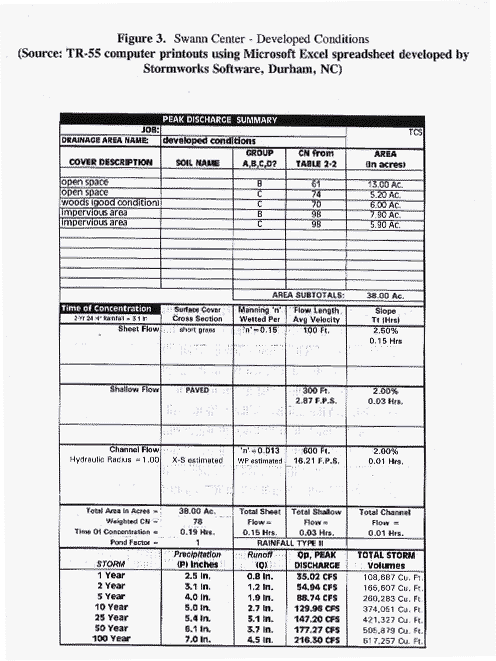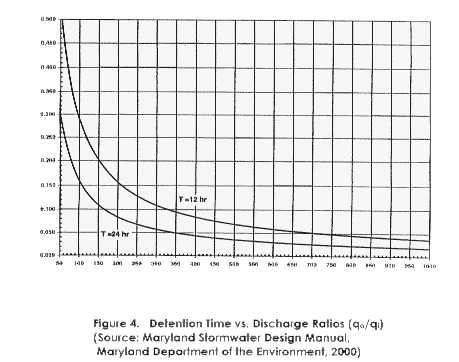![]() In
this design example, the NRCS TR-55 method is used as the design methodology.
In
this design example, the NRCS TR-55 method is used as the design methodology.
Design Example 1: Residential Development - Swann Center
This section presents a sizing example for a medium residential subdivision, Swann Center. The layout of the Swann Center subdivision is shown in Figure 1.
In this design example, the NRCS TR-55 method is used as the design methodology.
Step 1. Compute WQv Volume
Criteria:
Step 1a. Compute Runoff Coefficient
This runoff coefficient is derived from Schueler's Simple Method.
Rv = 0.05 + (I) (0.009)
Where:
I = Impervious Cover (%)
Rv = 0.05 + (36.3) (0.009) = 0.38
Step 1b. Compute WQv
WQv = (P1) (Rv ) (A)
Where:
P1 = 90% Rainfall Event (Inches). Assume 0.9" in this example
A = 38.0 acres
WQv = (0.9 ) (0.38) (38.0 ac) (1ft/12in)
= 1.08 ac-ft
Check Minimum: (0.2 ) (38.0 ac) (1ft/12 ) = 0.63 ac-ft [okay]
Step 2. Compute Recharge Volume (Rev)
Step 2a. Determine Recharge Equation Based on Hydrologic Soil Group (Table 1).
|
Table
1. Recharge Based on Soil Group
|
|
|
HSG
|
Recharge
Requirement
|
|
A
|
(0.38)
(Rv) (A) / 12
|
|
B
|
(0.25)
(Rv) (A) / 12
|
|
C
|
(0.13)
(Rv) (A) / 12
|
|
D
|
(0.06)
(Rv) (A) / 12
|
Assume imperviousness is located proportionally in B and C soils.
Step 2b. Compute Recharge Volume
For "B" soils =[(0.25 inches) (.38) (.38 ac)/12"/ft] (0.60) = 0.18 ac-ft
For "C" soils =[(0.13 inches) (.38) (.38 ac)/12"/ft] (0.40) = .06 ac-ft
Add recharge requirement for both soils
Rev = (0.18 ac-ft) + (0.06 ac-ft)
= 0.24 ac-ft
![]() This
requirement can be met either with a structural practice, or with Stormwater
Credits.
This
requirement can be met either with a structural practice, or with Stormwater
Credits.
Step 3. Compute Stream Channel Protection Volume (Cpv):
Requirement: Provide 24 hours of extended detention for the 1-year event.
![]() Please
note that the length of detention may be smaller based on the stream resource.
In cold water trout streams, for example, the detention time may be as small
as 6 to 12 hours.
Please
note that the length of detention may be smaller based on the stream resource.
In cold water trout streams, for example, the detention time may be as small
as 6 to 12 hours.
Step 3a. Develop site hydrologic and TR-55 Input Parameters
Table 2 presents Input Parameters Per attached TR-55 calculations (see Figures 2 and 3).
| Table 2. Input Parameters for STP Sizing | |||||||
| Condition | CN | Tc | Qa, 1-yr | Q 1-yr | Q 2-yr | Q10-yr | Q100- yr |
| hours | inches | cfs | cfs | cfs | cfs | ||
| pre-developed | 63 | 0.35 | 0.2 | 4.62 | 13.58 | 50.38 | 102.6 |
| developed | 78 | 0.19 | 0.8 | 35.02 | 54.94 | 129.96 | 216.3 |

Step 3b. Compute Storage Volume
![]() The
following technique is based on the method described in Design Procedures
for Stormwater Management Extended Detention Structures, (Maryland Department
of the Environment, 1987).
The
following technique is based on the method described in Design Procedures
for Stormwater Management Extended Detention Structures, (Maryland Department
of the Environment, 1987).
Initial abstraction (Ia) for CN of 78 is 0.564: (TR-55) [Ia = (200/CN - 2)]
Ia/P = (0.564)/ 2.5 inches = 0.226
Tc = 0.19 hours
From TR-55, Exhibit 4-11 (NRCS, 1986):
qu = 740 csm/in
Knowing qu and T (extended detention time), find Qo/Qi from Figure 4, "Detention Time Versus Discharge Ratios."

Peak outflow discharge/peak inflow discharge (Qo/Qi) = 0.024
From TR-55, Volume of storage/Volume of runoff (Vs/Vr)
(Figure 6.1, page 6-2 of TR55)
For a Type II rainfall distribution,
Vs/Vr = 0.683 - 1.43(Qo/Qi)+1.64(Qo/Qi)2 - 0.804(Qo/Qi)3 (MDE, 1987)
Vs/Vr = 0.65
Therefore, Vs = 0.65(0.8 )(1/12)(38 ac) = 1.65 ac-ft
Step 3d. Define the average ED Release Rate
Qi is known (35.0 cfs), therefore,
Qo = (Qo/Qi) Qi = .024 (35.0) = .84 cfs
Step 4. Compute Peak Discharge Control Volume (Qp):
Control the peak flow from
10-year storm event to pre-developed levels.
Step 4a. Model Site Using TR-55 for 10 year storm
Per TR-55, Figure 6-1 (Page 6-2 of TR-55) for a Qin of 130.0 cfs, and an allowable Qout of 50.4 cfs, the Vs necessary for control is 2.83 ac-ft, with a developed CN of 78. (See TR-55 Worksheet 6a, Page 6-5 of TR-55). Note that 5.0 inches of rain fall during this event, with 2.7 inches of runoff.
Step 5. Analyze Safe Passage of 100 Year Design Storm (Qf)
Note that this design example doe not assume that control of the 100-year event is required.
At final design, provide safe passage for the 100 year event. Based on field observation, downstream conveyance will require analysis for passing the 100-year event through an existing culvert.
|
Table
3. Summary of General Storage Requirements for Swann Center
|
|||
|
No.
|
Category
|
Volume
Required (ac- ft)
|
Notes
|
| WQv | Water Quality Volume |
1.08
|
|
| Rev | Recharge |
.24
|
this volume is included within the WQv storage |
| Cpv | Stream Protection |
1.65
|
Average ED release rate is .84 cfs over 24 hours |
| Qp | Peak Control |
2.83
|
10-year, in this case |
| Qf | Flood Safe Passage | provide safe passage for the 100-year event in final design | |